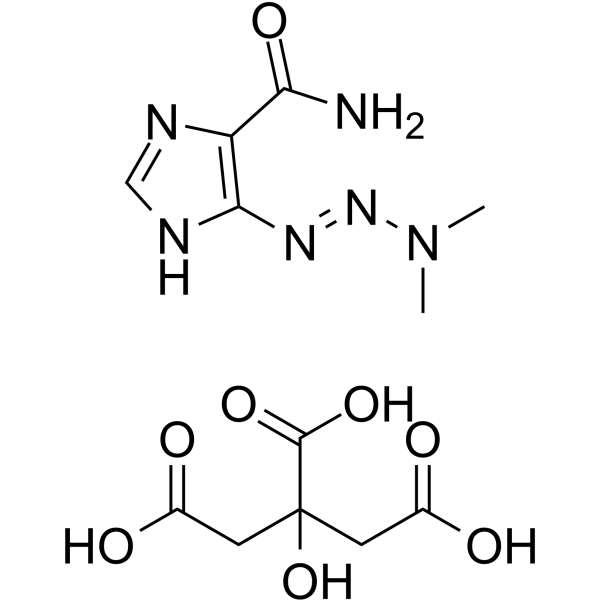| Description |
Dacarbazine citrate is a cell cycle nonspecific antineoplastic alkylating agent. Dacarbazine citrate inhibits T and B lymphoblastic response, with IC50 values of 50 and 10 μg/mL, respectively. Dacarbazine Citrate can be used for the research of apoptosis and various cancers such as metastatic malignant melanoma[1][2].
|
| Related Catalog |
|
| In Vitro |
Dacarbazine citrate has less pronounced inhibition of mitogenesis with IC50 values of 50 and 10 μg/mL for T and B cells, respectively[2]. Dacarbazine citrate (30 μM, 0-14 min) evokes a concentration-dependent calcium response in hTRPA1-HEK293 cells with an EC50 value of 23 μM and selectively activates the human TRPA1 channel[3]. Dacarbazine citrate (100-10,000 μM, 24 h) has cytotoxic action on B16-F10 melanoma cells[3]. Cell Viability Assay[3] Cell Line: B16-F10 cell Concentration: 100-10,000 μM Incubation Time: 24 h Result: Reduced cell viability to 3,000 and 10,000 uM, with an inhibition percentage of 62 ± 2% after 24 h of incubation.
|
| In Vivo |
Dacarbazine citrate (1 mg/kg, i.p.) evokes a concentration-dependent calcium response and the maximum calcium response with an EC50 value of 16 μM in a subset of cells of cultured mouse DRG neurons and excites TRPA1 in rodent sensory neurons[3]. Dacarbazine citrate (1 mg/kg, i.p.; 1, 3, 5 and 7 days for chronic pain or 1 mg/kg, i.p. for acute treatment) induces mechanical and cold allodynia in mice[3]. Dacarbazine citrate-induced nociception can be reduced by TRPA1-deficient mice and antisense oligonucleotide for the TRPA1 receptor[3]. Dacarbazine citrate-induced chronic nociception can be reduced by selective TRPA1 receptor antagonists and antioxidants[3]. Dacarbazine citrate-induced nociception can be resisted by RPA1 antagonist or an antioxidant in a tumor-associated cancer pain model[3]. Animal Model: C57BL/6, Trpa1+/+ or Trpa1−/− mice[3] Dosage: 1 mg/kg Administration: 1 mg/kg, i.p. (for acute treatment);1 mg/kg, i.p.; 1, 3, 5 and 7 days (for chronic pain) Result: Caused mechanical allodynia with acute or repeated administration.
|
| References |
[1]. Abdullah A Al-Badr, et al. Dacarbazine. Profiles Drug Subst Excip Relat Methodol [2]. J M Rojo, et al. Inhibition of T and B lymphoblastic response by mithramycin, dacarbazine, prospidium chloride and peptichemio. Chemotherapy. 1983;29(5):345-51. [3]. Int J Cancer, et al. Dacarbazine alone or associated with melanoma-bearing cancer pain model induces painful hypersensitivity by TRPA1 activation in mice. Int J Cancer. 2020 May 15;146(10):2797-2809.
|
